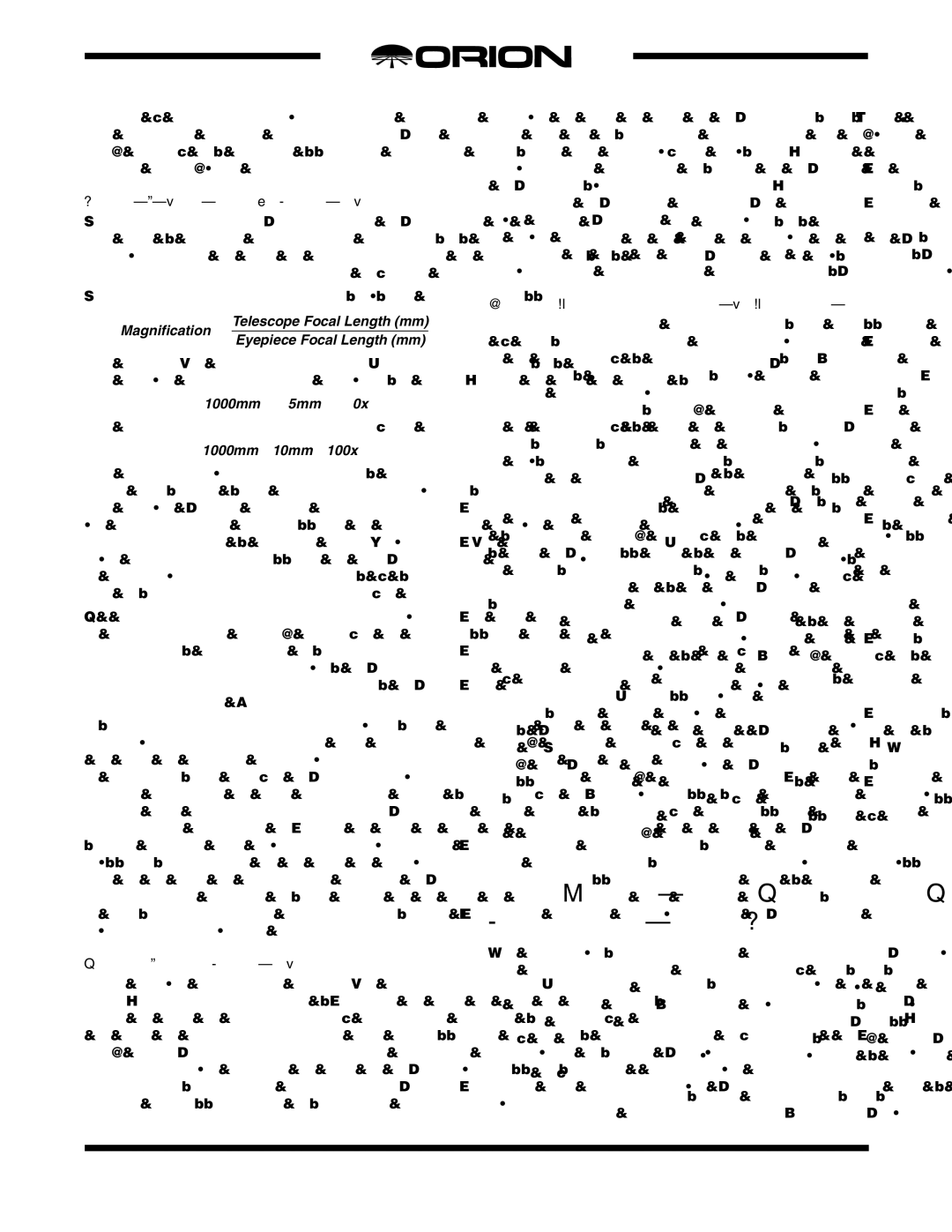achieved by focusing the finder scope on a bright star. Once the image appears sharp, retighten the locking ring behind the objective lens cell. The finder scope’s focus should not need to be adjusted again.
Magnification & Eyepieces
Magnification, or power, is determined by the focal length of the telescope and the focal length of the eyepiece. Therefore, by using eyepieces of different focal lengths, the resultant magnification can be varied.
Magnification is calculated as follows:
Magnification = Telescope Focal Length (mm)
Eyepiece Focal Length (mm)
The SkyView Pro 120 EQ has a focal length of 1000mm, which when used with the supplied 25mm eyepiece yields:
1000mm÷25mm= 40x
The magnification provided by the 10mm eyepiece is:
1000mm÷10mm=100x
The maximum attainable magnification for a telescope is directly related to how much light it can gather. The larger the aperture, the more magnification is possible. In general a fig- ure of 2x per millimeter of aperture is the maximum attainable for most telescopes. Your SkyView Pro 120 EQ has an aper- ture of 120 millimeters, so the maximum magnification would be about 240x. This level of magnification assumes you have ideal conditions for viewing.
Keep in mind that as you increase magnification, the bright- ness of the object viewed will decrease; this is an inherent principle of the laws of physics and cannot be avoided. If mag- nification is doubled, an image appears four times dimmer. If magnification is tripled, image brightness is reduced by a fac- tor of nine!
Always start with your lowest power eyepiece and work your way up. Start by centering the object being viewed in the 25mm eyepiece. Then you may want to increase the magnification to get a closer view, if you wish. If the object is off-center (i.e., it is near the edge of the field of view) you will lose it when you increase magnification, since the field of view will be narrower with the higher-powered eyepiece. To change eyepieces, first loosen the securing thumbscrews on the diagonal. Then care- fully lift the eyepiece out of the diagonal. Do not tug or pull the eyepiece to the sides, as this will knock the telescope off its target. Replace the eyepiece with the new one by sliding it gently into the diagonal. Re-tighten the thumbscrew, and refo- cus for your new magnification.
Use of 2" Eyepieces
A feature of the SkyView Pro 120 EQ is its ability to use either 1.25" or 2" barrel-diameter eyepieces. At low magnifications, 2" eyepieces can give a wider field of view than standard 1.25" eyepieces. This is especially desirable for observing deep-sky objects, as many of them appear quite large, but faint. If you want to use 2" eyepieces, you will also need to use a 2" star diagonal for refractors, or a 2" extension tube, so that the tele- scope will properly come to focus.
To use 2" eyepieces, simply loosen the two large thumbscrews on the 2" adapter that are just in front of the thumbscrew that holds the provided 1.25" star diagonal in place. Once these thumbscrews are loosened, the entire back end of the focus- er, including any 1.25" diagonal and eyepiece that may be attached, comes off, exposing the 2" diameter focuser draw- tube Now, insert your 2" star diagonal into the drawtube and secure with the two thumbscrews loosened previously. Insert a 2" eyepiece into the diagonal, secure it in place with the thumbscrew on the diagonal, and you’re ready to observe.
Note About Chromatic Aberration
Chromatic aberration literally means color distortion. When- ever light passes through one material to another, light of dif- ferent wavelengths (color) is bent by different amounts. This is
aproblem that plagues refractor-type telescopes, since light passes through both air and glass to form an image. Most astronomical objects emit a spectrum comprised of many dif- ferent wavelengths of light, so each wavelength will be bent by
aslightly different amount when passing through a lens. This results in each color of light reaching precise focus at a slightly different point, which will provide unacceptable images.
Achromatic refractors, like the SkyView Pro 120 EQ, are designed to minimize chromatic aberration to acceptable lev- els. The objective lens is actually comprised of two individual lenses, called elements, made of different materials, which bend light in slightly different ways. By precisely spacing and shaping the elements, the chromatic aberration incurred when light passes through air and the first glass element is reduced by the way the second element bends the light. The result is an image that is much better color corrected than a non-ach- romatic (one element) objective lens.
Even with the achromatic lens design, however, the SkyView Pro 120 EQ will suffer a bit from chromatic aberration due to its large aperture and short focal length. This will be notice- able, to some degree, on extremely bright objects, such as the Moon and bright planets. What you will notice is that the object, when focused, has a slight “purple-halo” around it. This will not present a problem for most observers, as the eye read- ily adapts to the view and is still able to distinguish fine details. Chromatic aberration will never inhibit deep sky observing, as deep sky objects are too faint to cause any noticeable color distortion.
6.Setting Up and Using the Equatorial Mount
When you look at the night sky, you no doubt have noticed that the stars appear to move slowly from east to west over time. That apparent motion is caused by the Earth’s rotation (from west to east). An equatorial mount (Figure 6) is designed to compensate for that motion, allowing you to easily “track” the movement of astronomical objects, thereby keeping them from drifting out of your telescope’s field of view while you’re observing.
This is accomplished by slowly rotating the telescope on its right ascension (R.A.) axis, using only the R.A. slow-motion

